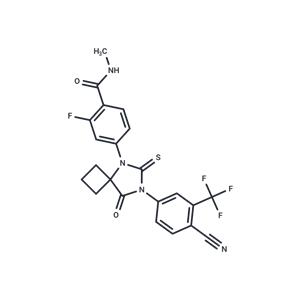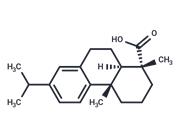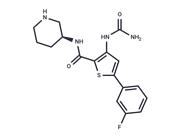| Name | RD162 |
| Description | RD162 is a non-steroidal antiandrogen (NSAA) specifically binding to the androgen receptor (AR). |
| In vitro | RD162 has little to no binding to the progesterone, estrogen, or glucocorticoid receptors. RD162 (1-10 μM) suppressed growth and induces apoptosis in the human prostate cancer cell line VCaP which had endogenous AR gene amplification[1]. |
| In vivo | RD162 (20 mg/kg) is ∼50 percent bioavailable after oral delivery with a serum half-life of about 30 hours. RD162 (10 mg/kg; oral gavage) causes all tumors regressed. RD162 (0.1, 1, 10 mg/kg; oral gavage) consistently reduces luciferase activity with 10 mg/kg/day human LNCaP/AR xenografts grown in castrated male mice whereas lower doses of 0.1 and 1.0 mg/kg/day has minimal effect. RD162 substantially reduces cellular proliferation after 5 days[1]. |
| Storage | Powder: -20°C for 3 years | In solvent: -80°C for 1 year | Shipping with blue ice. |
| Solubility Information | DMSO : 50 mg/mL (104.94 mM)
|
| Keywords | inhibit | prostate | RD162 | Androgen Receptor | VCaP | Inhibitor | castration | RD 162 | NSAA | RD-162 | LNCaP | diarylthiohydantoin | orally |
| Inhibitors Related | Dehydroisoandrosterone 3-acetate | Bicalutamide | 2,2,5,7,8-Pentamethyl-6-Chromanol | S-23 | Bavdegalutamide | Enzalutamide | Adrenosterone | Allura Red AC | SK33 | Sunset Yellow FCF | Ostarine | Flutamide |
| Related Compound Libraries | FDA-Approved & Pharmacopeia Drug Library | Target-Focused Phenotypic Screening Library | Bioactive Compound Library | Drug Repurposing Compound Library | Anti-Prostate Cancer Compound Library | Anti-Cancer Approved Drug Library | FDA-Approved Drug Library | Bioactive Compounds Library Max | Anti-Cancer Drug Library | Transcription Factor-Targeted Compound Library |

 United States
United States



